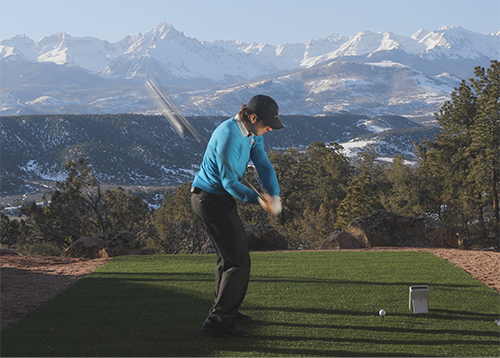Brooks Koepka 2 Moves For Consistency in Golf
Brooks Koepka 2 Moves For Consistency in Golf
Description
Congrats to Brooks Keopka on his amazing final round of 65 to claim his first European Tour victory at the Turkish Airlines Open! You must check out this video on Brooks Keopka if you have been struggling with... ▪ Your head moving too much during the entire swing ▪ Coming over the top ▪ Maintaining your spine angle throughout the swing In this video, I'll show you 2 key moves to get you well on your way to playing more consistent golf than you ever have. I'll also discuss a drill that you can try out at home that will teach you how to maintain your spine angle throughout the golf swing and help you overcome some of your biggest swing flaws.
Video Practice Points
- Minimize the amount of lateral head movement in your golf swing by rotating your shoulders around your axis properly.
- Maintain spine angle by keeping your hips back and loading and unloading the lower body properly.
- Keep your head behind the golf ball for as long as possible for consistent ball striking.

This week I'm going to be focusing in on two key moves in Brooks Koepka's golf swing that allow him to maintain consistent power and consistent ball striking. I'm also going to be discussing a drill that's going to help you overcome loss of spine angle in the hitting area. Let's go ahead and get started.
Okay, so the 24 year old Florida State graduate, Brooks Koepka, gets his first victory on the European Tour with a late charge on Sunday and fights off Ian Poulter, so congratulations to Brooks on his first European Tour victory. This week I'm going to be focusing in on two really key areas of his golf swing that he does so well in order to be able to maintain a lot of consistent power and a lot of consistency with his ball striking. You're going to be able to understand when you start to look at your own golf swing on camera how these areas can affect your game in a number of ways and how it can probably lead to a lot of the problems that you're seeing on the golf course.
I'm also going to go through a drill towards the end of the analysis that you can try out at home that's going to help you overcome the hips coming forward and that early extension of the spine. I know that's one of the more common areas that we see from golfers is that we see the hips coming forward, we see a lot of right side dominance, and in turn that creates this mess of spine angle problems where, you know, we really want to think of the spine as being kind of the axis and we want to rotate around it and keeping it as neutral and no change to it as possible. That's the idea. In order to play consistent golf is that we want to be able to rotate around our axis, not have much change in shape of the spine, and we also want to keep our head very quiet.
Let's go ahead and take a look here. I'm going to mark a few lines on the screen for us. I'm going to mark down the spine here. I'm also going to mark a line down off of the back of the tush. This is a line you'll see us use quite often here at Rotary Swing is that we draw lines straight down from the back of the tush because if the hips were to come forward, you would notice that spine angle changes quite a bit, especially in the downward move. All right, I'm also going to mark the trail shoulder here, the position of the trail shoulder and then from a face on perspective, what I'm going to mark is where the head position is at address, and I'm also going to mark a line from the trail shoulder, down into where that head position was.
From a down the line perspective, let's take a good close look at what he does so well here. Gets good load up to the right side. All right, loaded up into that trail side very well. He's got the hips still staying back and he's still been able to maintain his spine angle beautifully. Okay, so you see how the spine angle is virtually dead exactly the same as it was at address and then in the downward move, you're going to see a very common move here, a little sit to the left side, to that lead side, gets over there, and then he's still keeping those hips back down into the hitting area. Notice how these hips have not come drastically forward. He's been able to maintain that original spine angle.
He's actually maybe even increased his angle, but another big note here is take notice of where his right shoulder is. It's virtually exactly where it was at the address position. We don't see it moving forward. We don't see it out breaking through this line and that's one of those areas for amateur golfers when you get to the top part of your golf swing, you start to push really hard from the right arm and the right shoulder. If you've noticed yourself on camera with that right shoulder moving through that line, or your hips coming forward, chances are you're going to be a really steep swinger of the golf club and you're going to be more over the top. If you've been one of those people that have fought over the top, really kind of pay attention to what your right shoulder's doing in the downward move, try to keep it a little bit more relaxed, a little bit more passive, and let the left side of the body really kind of control things that are going on.
We're talking from a right-handed perspective this week. Again, if you look at the face on view, and for those golfers that have really kind of struggled with a lot of lateral head movement either in the takeaway, the back swing, or the downward move, Brooks does something extremely well in his golf swing that you really want to play close attention to here. You're going to see from a face on perspective, we get loaded up to the top. You can see the head moved, maybe an inch, inch and a half or so. Not a big deal. We want to allow the head to move just a little bit, so if you've noticed your golf swing and your golf swing when you watch it on camera, that you see a lot of this maybe four, five, six inches of lateral head movement, what that can be attributed to is this lead arm, or this lead shoulder, pushing across your center.
When you start to push your lead shoulder across your center, what that's doing, number one, is it's not allowing you to rotate your shoulders perpendicular to your axis, which is the spine, and when that happens then your chances are that your spine is starting to change shape. It's starting to either straighten up and it's also creating a lot of lateral head movement. Now you can kind of grasp ahold of the idea of how important it is to be able to rotate the shoulders perpendicular to your axis. That will teach you, number one, how to keep the head more quiet and it will also teach you how to build up power in your mid-section. If you've been one of those people that gets a lot of this lateral head movement, you won't be able to feel those abs and those obliques really starting to contract. Really focus on, you know, get yourself a mirror or a camera, focus on it from the down the line perspective, and take a good close look at it.
See, okay, I'm going to load up to the right. I want to rotate my shoulders around my axis and make sure that you're maintaining that spine angle as it was at address position. From a downward move here, from a face on perspective, he does something extremely well on his golf swing. We're going to get him down into the hitting area here. You're going to see the head move forward just a slight amount, and then as he's starting to get the hands down in front of that trail thigh, you're going to see that the head goes back in behind the original starting point here.
What he's done, because he's got a driver in his hands, he's got the ball position a little bit more forward, you can see that he's increased his axis tilt. He hasn't lost his spine angle, again, so let me show you from a down the line perspective. Down into the hitting area, okay you can see that the spine angle's been able to maintain the same, but his axis tilt has increased which in turn has got the spine now facing a little bit more outside of his lead knee and he's got his head back in behind the golf ball.
Also, take notice of where the right shoulder is. You can see that the right shoulder is virtually where it was at the address position. This is where he's going to be starting his release. He's going to be starting to unravel that angle in the right arm and that right hand and he's going to start to extend through the hitting area. Pay very close attention to these next few frames as I start to work through here. You're going to see that he maintains his head position behind the golf ball very long, so the hands are about pocket height. All right now we're going to work a little bit further. Now they're at about chest height here and the head is still behind the golf ball. Hands are now getting up around the shoulder height and now, as he's starting to get up into his finish position, that's when the head starts to come forward.
All right so you can see that what he's done, and the reason why we actually only have one follow through video on the website is because, what a follow through really is, and if you have yourself well enough trained to get speed at the right spot, and that's in the hitting area, a follow through is really just the safest way to decelerate the golf club. We want the hands and arms to, when they're decelerating the golf club, to be able to pull us up onto our right toe. If you've noticed that you get your head moving out in front of the original position too early, then double check to make sure that your trail shoulder has not moved across your center, or pushed across your center, just as it would in the takeaway or the back swing. If you push it across your center, then you can run the risk of having a lot of lateral head movement. You can lose spine angle and then in turn, you're going to just run into problems with maintaining consistency in ball striking. That can be a big issue.
The big things that you want to work on in your golf swing are you want to make sure that you keep the head more quiet. You really want to try to keep the head in behind the golf ball, especially into impact, and then post impact still allow the head to stay very, very quiet. Allow the hands and arms to feel like they're reaching and extending out in front of you, and then allow, you know, once things get pass the nine o'clock region or past the hip region, allow the hands and arms to pull you up onto your finish position, up onto that right toe. That will help you keep those hips back. It will help you maintain spine angle and it will certainly help you not get that right side pushing across your center and steepening up the golf club.
A good drill, as I told you guys I would talk about for you guys to try at home, this is one that I have a lot of my students, it's actually a drill that I do myself, is if you stick your tush up against a wall and grab yourself like a seven or an eight iron, and what you want to do is just have your tush lightly touching the wall, and then go ahead and just make some good nine to three golf swings, and what you want to do is go ahead and shift your hips to the right. Make sure you feel your weight load into that right side, that right leg for stability, and go ahead and swing the arms back to the nine o'clock region. Pause, hold that in a static position, and then shift over to the left side, and feel the weight over into that left heel, left ankle area, and then once you feel that happen, then go ahead and swing the arms and release all the way through to the three o'clock position.
As you're doing this, try to keep your right tush back lightly touching the wall all the way through the hitting area. That's going to give you the correct sensation of how to keep the hips back and it's also going to train you how to maintain spine angle. Now this is not a drill that I want you guys to overdo, but I want you to be able to feel the differences, so if you've ever seen your hips coming forward and you've lost the tush line quite a bit, then try this drill out and then slowly start to work yourself away from the wall, and then work on making sure that you know how to load and unload properly without getting yourself to be pushed and getting those hips to come forward.
Also double check your right shoulder position. Make sure that you don't start your downward move and start to push your right shoulder across your center because that can cause you to lose lag. It can cause you to steepen the golf club up, and then we have a mess of problems with being over the top and we create a big slice or a big pull hook. Those are the drills I want you guys to try out, so make sure that you're watching your spine angle. Make sure that you're watching your head position, keep in it behind the golf ball. Then make sure you're trying to keep it in behind the ball as you're extending out through to the three o'clock position and you'll be able to play a lot more consistent, a lot better golf.
Couple videos on the website I want you guys to check out. That's going to be, Losing the Tush Line, that's in the advanced downswing section. That's a great video to show you how to maintain your spine angle. You actually talk about how we actually increase a little bit of the tush line in the downward move and it will help you overcome a lot of those issues that you've been struggling with. Also I want you to double check another great video on the website. It's called, Roll of the Right Foot. It's going to help you understand what the right foot's doing in the downward move. You could see here Brooks has got his right heel up off the ground quite a bit. This Roll of the Right Foot video is going to teach you how the right foot can act as more of a braking mechanism and it's also going to give you kind of a little bit of a checkpoint for those of you golfers that have really struggled with the hips coming forward.
All right, so those two videos. They're going to show up on the recommended videos to the right of the video player. Check those out. That's a great couple of videos that can help you overcome a lot of these issues. Also, there's a video if you've been struggling with your takeaway seeing a lot of that lateral head movement, we actually have a video that's called, Head Moving Off the Golf Ball. I'm also going to put that in the recommended video for you guys to check out as well. Understand that we really want to, in order to maintain consistency, we want to be able to rotate our shoulders around our axis, which is our spine. We want to maintain that spine angle and we want to keep our head as quiet as possible for a lot of consistency and a lot of consistent power.
All right guys so let's get out there and play some great golf. I look forward to working more with you guys in the future. Let's make it a great day.
Testimonials

-Dr. Jeffrey Broker, Assoc. Prof. in Biomechanics at University of Colorado at Colorado Springs and Former Senior Biomechanist for U.S. Olympics Committee

-Hub Orr - Happy PREMIUM MEMBER of RotarySwing.com

-Sam Jarman, PGA Golf Instructor in the UK

Build the perfect golf swing following the most advanced online golf swing learning system!
JOIN OUR 445,145 MEMBERS AND GET INSTANT FREE ACCESS TO DOZENS OF VIDEOS!



